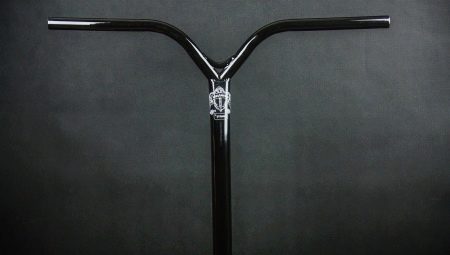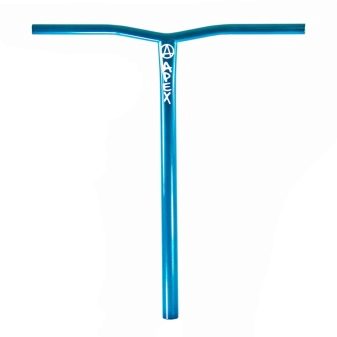Scooter steering wheel: varieties and tips for choosing

Each steering wheel in a scooter can perform several functions at once: it guides the vehicle's course, absorbs a significant part of the load and vibrations from riding on uneven roads, and also insures the scooter against loss of balance and injury. In this article, you will learn about the most popular types of handlebars for stunt, kids and hobby scooters, as well as tips for buying and choosing them.



Views
There are several separate classifications of types of handlebars for scooters, depending on the material of manufacture, diameter and height (or dimensions of the model), as well as the shape of the handlebar itself.
The information below should help you when choosing handlebars for both professional (stunt) and children's, amateur scooters.

Manufacturing material
Typically, scooter handlebars are made of three materials: steel, aluminum and titanium. You should take a closer look at the pros and cons of each of these materials.
- Steel. This material is the classic and most common material for the manufacture of handlebars specifically for stunt scooters. To create them, a special chromium-molybdenum steel is usually used, which is characterized by high strength, as well as ease of welding and processing. The main advantage of steel handlebars is that in case of breakage or the formation of cracks on them, ordinary welding will be enough to repair these cracks. Despite this plus, steel models of handlebars are usually heavy (up to 1.5 kg), which greatly affects the speed of the scooter and its maneuverability.


- Aluminum. Aluminum models are the second most popular in stunt bike designs - aluminum units perform much better in quiet riding on good roads.Their weight is much less than that of steel models (up to 0.85 kg are the heaviest), but aluminum is not nearly as durable as steel. The main problems begin when choosing the dimensions of a handlebar made of aluminum - the wider it is, the more likely it is to break under load. Unfortunately, aluminum handlebars are very rarely repairable, since welding on this material is very problematic and ineffective.
This requires a special argon welding, but even it will not be able to weld a solid fracture with high quality. In addition, finding a crack in an aluminum handlebar is not an easy task.


- Titanium. Today, titanium units are very rare even in professional stunt scooters. Typically this material is used to create certain parts (such as steering columns) on a scooter. A distinctive feature of titanium rudders is low plasticity, as well as the lowest possible weight of 0.5-0.6 kg. Unfortunately, titanium is not suitable for performing serious tricks and prolonged loads, and therefore is rarely used.

Diameter
The frame diameter affects the total weight of the scooter, its ductility and strength. The diameter of the handlebar frame should be selected based on the type of compression system of the model: ICS, SCS, IHC or HIC.
- The standard diameter (such models are called narrow) is 31.8 mm. This size is considered universal, since it is compatible with almost all compression systems and can be fixed with any clamp option (even if the latter are adapted for oversized handlebars). With this diameter, it is usually the steel models of the scooter handlebars that are made.


- "Oversize" (also called wide) - this may include steel or aluminum models of handlebars with a diameter of 34.9 mm. Usually such handlebars are used only for HIC compression systems, however, due to the standard size of the inner diameter, they can be adjusted to the SCS system. To dock such rudders with other systems, additional purchased parts are usually used.

- "Oversize alloy" - units with a diameter of this type are exclusively aluminum models. The technique of thickening the frame walls is used here in order to make the scooter's structure more durable, because aluminum itself is a material much less durable than steel. Oversized alloy units can be mounted on the same compression systems as standard models, however, unfortunately, they cannot be tightened with all clamp types.
Handlebars of this size are not designed to fit the HIC system.


Height
There are a number of factors to consider when choosing a handlebar height for an adult or child scooter.
- The handlebars should be approximately in the belt area (when standing on the deck) of the rider.
- According to raiders, lower handlebars are better for stunt scooters, as this will directly affect maneuverability and trick performance. Others are sure that scooters with long handlebars can be used for tricks, but for performing special tricks such as manuals. For children, high (in comparison with their height) options are more suitable - they allow babies to maintain balance and insure against falls.
- If you choose a steering wheel for a child's scooter, then everything here directly depends on the child's height. For children with a height of 80 to 95 cm, models from 50 to 70 cm should be selected. All variants of scooters with a higher height are intended for adolescents and adults.
- Ideally, the scooter's arms should be at the level of the solar plexus at right angles to the handlebars. This is the most comfortable position for riding on level ground.
In addition, the scooter should not hunch over the steering wheel or reach for it with your hands. The posture of a person should in any case remain straight.


The form
All scooter bars can also be divided in shape. When choosing this indicator, first of all, they are guided by the driving style. That is, these forms are created exclusively for stunt and professional scooter riding.
- T-shaped. This form is considered a classic for raiding on flat and uneven surfaces. The main condition when buying a steering wheel with this shape is to try not to overload the scooter frame with tricks or loads. Among the straight handlebars with a T-shape, we can highlight the models of the "Comet" series made of heat-treated steel, which are specially created for stunt riding on a scooter. The weakest point of any rudder of this shape is the welding of the supporting and main pipes.
If a raider uses such a unit in aggressive and fast driving with regular loads, then the scooter will break down in the area of the crosshair.


- Aggregates. The Y-type is considered to be more comfortable, lighter and more durable than the T-type. The so-called struts or stays in these types of handlebars help to evenly distribute the load from the frame to the handles themselves, in addition, these stays can be used by the raider for additional control over the scooter. Such handlebars have a comfortable anatomical shape, which does not allow the hands to slip while driving. Models of this type are considered ideal for use by professional raiders, but unsuccessful braking with such a rudder or loss of control can end up very badly for a scooter.

Backsweep
Beginner scooters rarely pay attention to the presence or absence of backwip - this word refers to the special position of the handles on the steering wheel of the scooter, where the latter are directed towards the body of the scooter. Such handles do not greatly affect the scooter's maneuverability and control - here it is more about habit, as well as the chosen riding style.


How to choose?
Many aspiring raiders make a lot of mistakes when choosing their first stunt scooter. The same goes for parents who want to find the perfect scooter for their child, but do not know what points to pay attention to. The following list of recommendations should help you decide which scooter bar is best for you.
- If we talk about choosing a steering wheel from the point of view of the material for making such a unit, then you need to decide why exactly you need a scooter. If you want to buy a model for amateur use, or choose a gift for your child, then it would be most logical to buy an aluminum model. Such models will be durable, lightweight and not particularly expensive. If you buy a handlebar for a stunt scooter, then it is more logical to choose steel models - they are more durable, shock-resistant and durable, albeit heavy.

- An indicator such as the diameter of the frame should also be selected based on the dimensions of the fork of your scooter and its compression system. To find the best steering wheel for your vehicle, take the scooter deck with you to the store - so you can check on the spot whether a certain steering wheel suits you, and whether there is any backlash when riding with it.
Keep in mind that the larger the diameter of your handlebar frame, the more the scooter itself will weigh. In addition, in the case of materials such as titanium or aluminum, increased thickness is not at all a guarantee of strength - in some cases, the opposite is true.


- To simplify the choice of such an indicator as the height of the steering wheel, it is better to choose exactly the telescopic versions of the model, where the steering wheel can be raised, or to increase its length. This function will be especially relevant in large families with growing children. Over time, you will not need to buy a new scooter for your child. And also when choosing a height, you need to be guided by the dimensions of the steering column that fixes the scooter frame.

- Those who decide to ride scooters professionally and improve themselves in performing tricks should not think that the wider the steering wheel width, the better it is to control it - it all depends on the riding style and stunts you choose.For example, wide models of rudders are suitable for performing vips and degree tricks, narrower ones will perfectly show themselves when performing barspins, brayflips or bartwists. If we talk about the standard width, then this indicator should be approximately equal to the width of the raider's shoulders.
For children, handlebars that are too wide are not worth buying - they will make the scooter model clumsy and discourage the kids from improving their ride.

How to choose a wheel for a scooter, see below.








